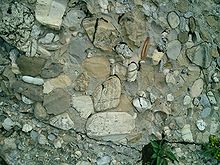Molasse
In geology, "molasse" (/məˈlæs/) are sandstones, shales and conglomerates that form as terrestrial or shallow marine deposits in front of rising mountain chains.
The molasse deposits accumulate in a foreland basin, especially on top of flysch-like deposits, for example, those that left from the rising Alps, or erosion in the Himalaya.
These deposits are typically the non-marine alluvial and fluvial sediments of lowlands, as compared to deep-water flysch sediments.
[1] The molasse can sometimes completely fill a foreland basin, creating a nearly flat depositional surface, that nonetheless remains a structural syncline.
Molasse can be very thick near the mountain front, but usually thins out towards the interior of a craton; such massive, convex accumulations of sediment are known as clastic wedges.
